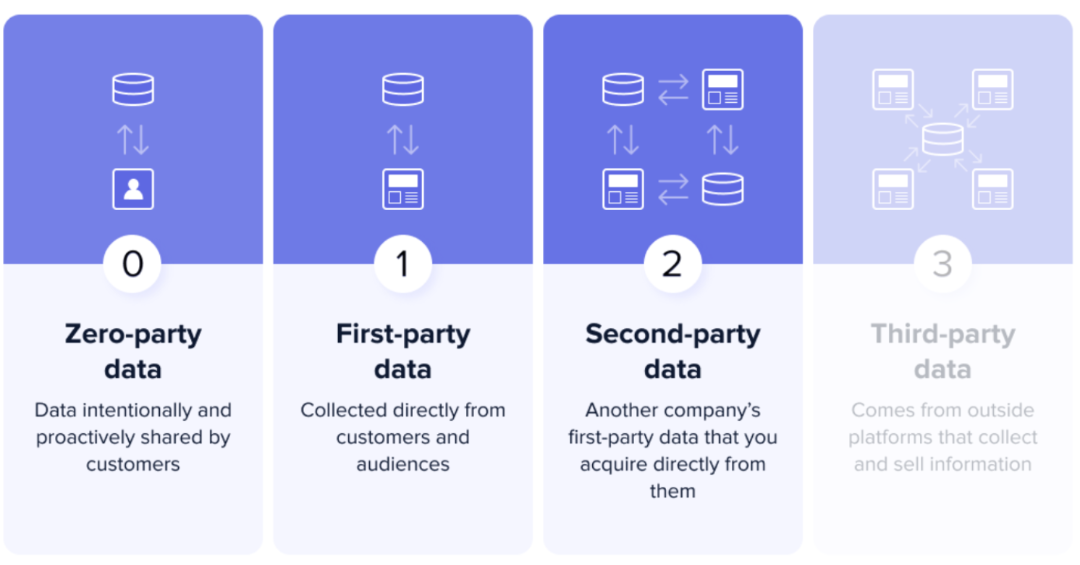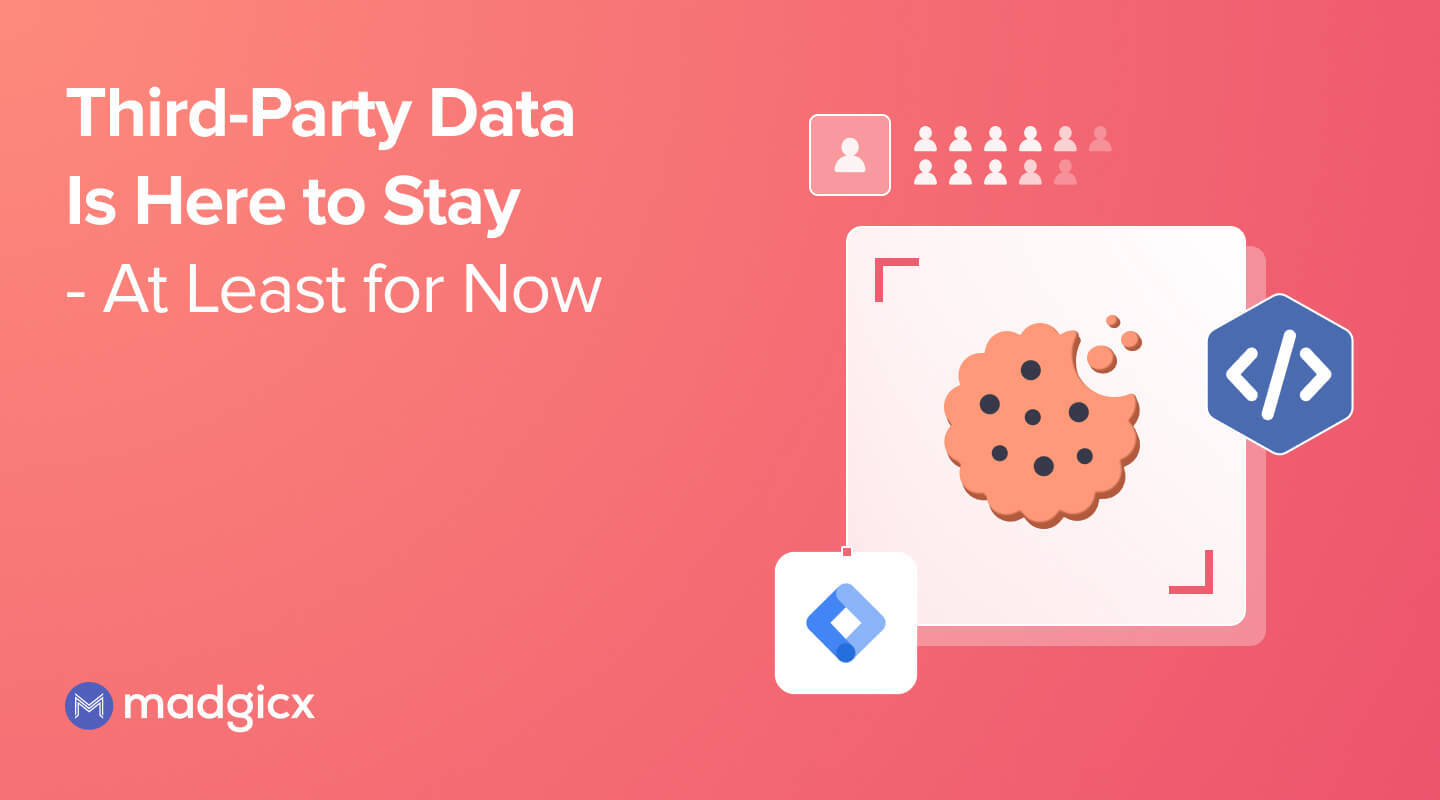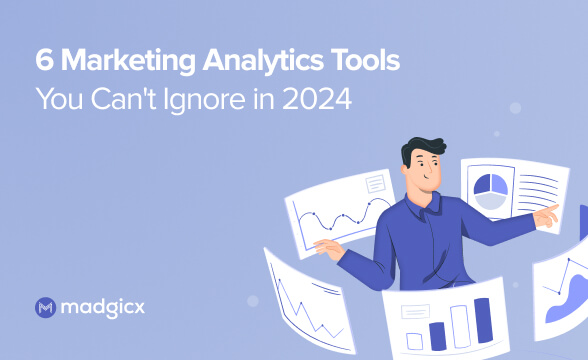Third-party data is holding its ground, but for how long? Let's unpack the challenges in privacy regulations and explore strategies to thrive despite them.
Ever wondered why those shoes you glanced at once keep popping up in your feed? That’s third-party data at work, subtly shaping digital. Today, we’re exploring this type of data and how it’s quietly orchestrating our online experiences.
What is third-party data?
Let’s say you’re at a party. You’re directly conversing with someone (that’s first-party data) while someone else is eavesdropping (that’s our third-party data). This eavesdropper collects snippets of your conversation; your likes, dislikes, and interests, and then shares this information with others to help them understand you better.
Third-party data in digital marketing acts as an eavesdropper, collecting information about your online behavior from sources like website cookies, data marketplaces, and pixel tags. This coveted information, gathered by specialized data-collection companies, helps businesses reach and learn about new audiences at scale.

Now, you might wonder, "Is third-party data illegal?" Well, no, but it's crucial to stay updated and understand the legality and ethics surrounding third-party data, especially in today's evolving privacy regulations.
Some third-party data examples:
This is a piece of code that you can place on your website. It allows you to measure the effectiveness of your advertising by understanding the actions people take on your website. Once configured, the pixel activates when someone acts on your website, such as visiting it, making a purchase, or adding an item to the cart. These actions, or events, are then recorded and can be reviewed in the Meta Ads Manager and Meta Events Manager.
This serves as a web tagging library specifically designed for site measurement, conversion tracking, and the utilization of data segments in Google’s products. The Google Tag Manager code integrates your website visitors into these data segments, thereby enabling targeted ad campaigns.
This tool is crucial in establishing connections with individuals who have interacted with your website or app. It transmits data to connected Google product destinations, aiding in the evaluation of your website and ad performance.
A single Google Tag Manager can be used across your entire website, linked to multiple destinations. This eliminates the need to manage separate tags for different Google product accounts.
Moreover, it’s important to note that the Google Tag Manager allows you to connect the Meta Pixel and other types of pixels. This feature enhances the management flexibility of various pixels by consolidating them through a centralized platform.
III. Hotjar
This code is designed to be integrated into your website. Once activated, it gathers and transmits valuable data into your Hotjar account, offering detailed insights into user interactions with your website or app.
A key feature of Hotjar is the heatmap, a graphical representation of data that shows the most popular areas of your website or app based on user interactions. This information includes details such as the pages or products they explored the most, and any other actions they took.
This allows you to easily identify high-engagement areas on your website or app, aiding in the optimization of user experience.
IV. FullStory
This is a digital analytics platform that records and analyzes how users interact with websites and mobile apps. It’s designed to help businesses comprehend user behavior and enhance the overall customer experience.
The platform captures and organizes all user actions, including clicks and page visits. Moreover, it automatically identifies issues, suggests opportunities for improving conversions, and provides a clear understanding of the actual customer experience associated with each data point.
Other data types:
Beyond third-party data, there are other crucial data types worth understanding. These additional data sets have a direct relationship with each other, offering insights into various dimensions that contribute to a comprehensive understanding of consumer behavior and preferences.

You'll notice the differences and nuances among the various data types, each serving a distinct purpose for your marketing endeavors:
1. Zero-party data:
This data type eliminates the middleman in data collection, establishing a direct line to your audience. Without intermediaries and waiting time, users freely share their preferences, desires, and needs, instantly and efficiently delivering valuable insights into your hands. Some examples of zero-party data are customer surveys, polls, live chats, and loyalty programs.
✅ The beauty of zero-party data lies in its voluntary nature, eliminating compliance concerns for advertisers.
2. First-party data:
First-party data is the information a company collects directly from its customers or users. It’s gathered through interactions with the company’s website, app, social media pages, customer feedback surveys, and transaction records.
This data is precious as it comes from people who have directly interacted with your brand or services, including details like customer names, email addresses, purchasing history, and user behavior on your website or app.
It is also considered the most reliable and accurate type of data as it comes straight from the source—your customers.
⚠️ Handling this data responsibly, respecting user privacy, and adhering to data protection regulations, are crucial.
3. Second-party data:
This is essentially another company’s first-party data that is collected by that company and sold or shared with you. This provides additional insights that may not be accessible from your customer data alone.
It is generally unique to you (not available or applicable to other advertisers), though not strictly “yours” in the sense that you did not collect it from users directly. This data aids you in marketing optimization and strategy refinement, enabling more effective audience connection.
Additionally, since this data is acquired directly from customers and audiences, it maintains a level of trustworthiness and relevance, making it a reliable source of insight.
❗Utilizing second-party data demands responsible handling to maintain its trustworthiness and relevance in your marketing endeavors.
Why use third-party data?
Third-party data isn’t perfect, but its value is unmistakable, offering unique insights that may not be accessible through other data types. But why is third-party data in marketing so indispensable? Let’s explore:
Enhanced audience targeting
One of the primary benefits of third-party data is its ability to enhance audience targeting. With third-party data, advertisers can access a wealth of information about potential customers, including their interests, behaviors, and demographics.
This allows for more precise targeting, ensuring that your ads reach the most relevant audiences.
Efficiency
A big perk of using third-party data is that it comes already segmented and organized by the provider. That means it’s ready for immediate use. You can swiftly integrate it into your marketing strategies and decision-making processes.
Broadened market insight
Third-party data provides a panoramic view of the overall market by aggregating information from various sources, offering insights that are not limited to a single perspective.
It goes beyond the confines of an advertiser’s user base, dissecting the behavior and preferences of potential customers across the web. This extensive analysis allows for a comprehensive understanding of consumer behavior.
This can help business owners identify new market segments, understand competitive landscapes, and uncover trends that may influence their strategies.
Improved personalization
Bullseye targeting and personalization are key to connecting with your audience. Consumers expect ads to be relevant to their interests and needs. Third-party data can offer the insights necessary to customize ads for individual users, enhancing engagement, conversion rates, and, consequently, your ROAS.
Smoother communication
Third-party data is pivotal in communicating data conversions back to advertising platforms like Meta and Google. It provides a comprehensive view of user behavior across various websites and platforms, which is not limited to an advertiser’s website or app.
This broad perspective enables advertisers to understand how users interact with their ads across different platforms and adjust their strategies accordingly.
☝While third-party data has its challenges, including privacy concerns and data quality issues, its benefits in terms of audience targeting, market understanding, and personalization make it a valuable tool in any advertiser’s toolkit.
How do you collect third-party data?
As a business owner, you don’t directly collect third-party data. Instead, you access it from companies that specialize in facilitating the collection of this type of data. The data can come from various sources:
- Websites and apps: Data from websites and apps is available through specialized marketplaces. For example, cookies track the pages visited, time spent on each page, and links clicked when a user visits a website. This data is then packaged and sold to advertisers for targeted advertising.
- Pixels: These are small pieces of code that are embedded in websites or apps to track user interactions. Pixels capture information such as page views, clicks, and interactions with content.
- Google Tags: Similarly to Pixels, these tags allow the collection of data on user behavior. Advertisers use this information to understand user engagement and tailor ad strategies.
- Data brokers: These are organizations that specialize in collecting, analyzing, and packaging large amounts of personal data, such as demographics, browsing habits, purchasing patterns, and social media activities. They then sell this information to other businesses.
- Social media platforms: These platforms have access to a wealth of user data, including likes, shares, and other interactions. Advertisers can access some of this data for targeting purposes.
- Purchase data: Some companies collect data on consumer purchasing habits. This data can provide valuable insights into consumer preferences and behaviors, making it highly coveted for advertisers.
What can you do with third-party data?
Third-party data can be used in a variety of ways, primarily to enhance your business strategies and decision-making.

Here are some common uses:
- Audience segmentation: Third-party data allows marketers to segment their audience based on various factors like demographics, interests, and behaviors. This helps in creating more targeted and personalized marketing campaigns.
- Performance measurement: Marketers can use third-party data to measure the effectiveness of their campaigns, track KPIs, and make necessary adjustments.
- Targeted advertising: By understanding the audience’s behavior, interests, and preferences, digital marketers can create more relevant and effective ads. This can lead to higher engagement and conversion rates.
- Content personalization: Marketers can use third-party data to personalize content for their audience. This could be in the form of emails, website content, or product recommendations.
- Customer retention: By understanding customer behavior and preferences, marketers can create strategies to increase customer loyalty and reduce churn.
- Competitive analysis: Third-party data can provide insights into market trends and competitors’ strategies, helping marketers position their products or services more effectively.
- Sales and lead generation: Businesses can use third-party data to identify potential leads and tailor their sales strategies accordingly.
Regulations that limit third-party data in 2023
Grappling with privacy concerns feels a lot like attempting a high-stakes obstacle course. Several regulations and initiatives have been introduced to limit third-party data usage.

Let’s discuss some of the key developments:
iOS14:
Apple's iOS14 in 2021 rollout sent advertisers into a frenzy. The privacy enhancements drastically altered how advertisers could target users by providing better transparency and control over app access to consumer data. This shift resulted in users being prompted to grant permission for tracking activities, causing many to opt out of ad tracking.
The change impacted essential tools like campaign measurement, frequency capping, and app install attribution, as these functionalities were limited if users chose to keep their information private.
Meta advertisers could also use a maximum of eight conversion events from a single website domain, affecting the ability to target ads based on specific user activities. However, these were not the only changes. The most significant change was the loss of data breakdowns and the decrease in the attribution window. Currently, 7 days is the new maximum for Meta, and only for clicks.
iOS17:
The forthcoming iOS17 is set to introduce even more privacy-focused features. These changes could potentially redefine user interactions when calling, messaging, or sharing content. This means the reach and effectiveness of certain advertising strategies may be affected.
We’re bidding farewell to the seamless tracking methods like Pixels and click IDs that effortlessly feed data back to Google or Meta for measuring ad performance.
These changes are set to disrupt your analytical toolkit. For users of GA4 or Meta Ads Manager, monitoring your campaign performance is about to become more challenging, with the looming possibility of receiving partial and unreliable information.
Creating efficient audiences, whether for retargeting or crafting lookalikes for acquisition, might also face increased challenges. It's worth contemplating a reevaluation of your analytics approach before these changes take effect.
Google’s Privacy Sandbox
The third-party cookies are crumbling soon 🍪💨 Google aims to create technologies that both protect people’s privacy online and give companies and developers tools to build thriving digital businesses.
The core goal is for Google Chrome to get rid of third-party cookies when new solutions are in place and reduce cross-site and cross-app tracking. The Privacy Sandbox APIs mandate browsers to adopt a new role, enabling a user’s browser to protect their identifying information while browsing the web.
You can expect these changes to come into effect in 2024 and they will be key in defining the future of digital privacy. Instead of being intimidated, let's view it as a chance to become pros at adapting our Meta campaigns.
Future-proof your Meta ads tracking with Madgicx
Designed for Meta ads, Madgicx Cloud Tracking ensures future-proof advertising by being fully compliant with current data protection regulations. It provides precise tracking of your ads, recording every click, view, and conversion, feeding it directly into your Meta Ads Manager.

Madgicx Cloud Tracking unlocks unparalleled insights into your ads with access to accurate performance data, laying the foundation for fine-tuning your ad strategy. But there’s more magic that sets it apart: Setup is super swift 🪄✨
Our team of experts will have your reliable tracking system up and running in just 2 days—no coding is required on your part. This means minimal disruption to your business operations, allowing you to focus on what matters most—growing your business.
Experience the benefits of Madgicx Cloud Tracking for yourself with our 14-day FREE TRIAL.
Third-party cookies are crumbling. Secure your Meta ads future with a robust first-party tracking solution. Madgicx Cloud Tracking is hassle-free—no coding headaches. Our experts set up your accurate first-party data tracking in 2 days! Launch your 14-day FREE TRIAL now.
Digital copywriter with a passion for sculpting words that resonate in a digital age.






.png)



